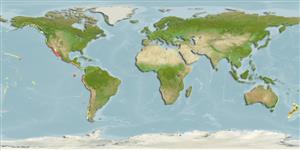>
Acanthuriformes (Surgeonfishes) >
Chaetodontidae (Butterflyfishes)
Etymology: Prognathodes: Greek, pro = first, in front of + Greek, gnathos = jaw (Ref. 45335); falcifer: Chaetodon meaning bristle tooth, falcifer meaning scythe-bearer (Ref. 4930).
More on authors: Hubbs & Rechnitzer.
Environment: milieu / climate zone / depth range / distribution range
Écologie
marin récifal; profondeur 10 - 150 m. Subtropical
Eastern Pacific: Santa Catalina Island, southern California, USA to Peru, including the Galapagos Islands.
Taille / Poids / Âge
Maturity: Lm ? range ? - ? cm
Max length : 15.0 cm TL mâle / non sexé; (Ref. 9286)
Description synthétique
Clés d'identification | Morphologie | Morphométrie
Épines dorsales (Total) : 12; Rayons mous dorsaux (Total) : 19 - 20; Épines anales: 3; Rayons mous anaux: 14 - 16.
Usually solitary. Found in rocky, boulder strewn areas (Ref. 5227). Close relatives are known to pinch off and eat tube feet of sea urchins and other echinoderms. Also feed on crustaceans, worms and other small invertebrates (Ref. 4930). Because they live in relatively deeper waters, they are seldom collected, thus, rarely seen in the aquarium trade (Ref. 4930). Oviparous (Ref. 205). Form pairs during breeding (Ref. 205).
Life cycle and mating behavior
Maturities | Reproduction | Spawnings | Egg(s) | Fecundities | Larves
Form pairs during breeding (Ref. 205).
Allen, G.R., 1985. Butterfly and angelfishes of the world. Vol. 2. 3rd edit. in English. Mergus Publishers, Melle, Germany. (Ref. 4858)
Statut dans la liste rouge de l'IUCN (Ref. 130435)
Menace pour l'homme
Harmless
Utilisations par l'homme
Pêcheries: commercial; Aquarium: Commercial
Outils
Articles particuliers
Télécharger en XML
Sources Internet
Estimates based on models
Preferred temperature (Ref.
123201): 14.2 - 22.9, mean 16.9 °C (based on 40 cells).
Phylogenetic diversity index (Ref.
82804): PD
50 = 0.5002 [Uniqueness, from 0.5 = low to 2.0 = high].
Bayesian length-weight: a=0.02239 (0.01117 - 0.04486), b=3.02 (2.85 - 3.19), in cm total length, based on LWR estimates for this (Sub)family-body shape (Ref.
93245).
Niveau trophique (Ref.
69278): 3.3 ±0.34 se; based on food items.
Résilience (Ref.
120179): Haut, temps minimum de doublement de population inférieur à 15 mois (Preliminary K or Fecundity.).
Fishing Vulnerability (Ref.
59153): Low vulnerability (10 of 100).
Nutrients (Ref.
124155): Calcium = 64.6 [28.6, 132.6] mg/100g; Iron = 0.852 [0.454, 1.592] mg/100g; Protein = 19.3 [18.0, 20.5] %; Omega3 = 0.213 [0.111, 0.406] g/100g; Selenium = 21 [9, 45] μg/100g; VitaminA = 29.5 [6.8, 126.0] μg/100g; Zinc = 0.963 [0.587, 1.498] mg/100g (wet weight);
